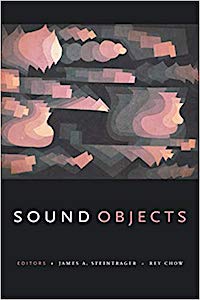As an area of research, sound studies is ever playing the disciplinary underdog, and it shows in some of the scholarship. There is a lot of nominalizing and theoretic land-grabby flag-planting. Some of it is justified. Some of it is not.
Swerving into its own theoretic lane, the AUDINT research unit invokes J.G. Ballard‘s description of a future environment as a jump off: “A place of strange echoes and festering silences, overhung by a gloomy miasma of a million compact sounds, it remained remote and haunted, the graveyard of countless private babels.” Under the guise of an ex-military cabal, they employ a haunotlogical approach to sound studies. Unsound: Undead (Urbanomic, 2019) is their “operations manual for a range of vibrational activities on the edge of perception.” Edited by Steve Goodman, Toby Heys, and Eleni Ikoniadou, the collection includes 64 short pieces by Dave Tompkins (How to Wreck a Nice Beach), Kodwo Eshun (More Brilliant Than the Sun), Kristen Gallerneaux (High Static, Dead Lines), Tim Hecker (Love Streams), Nicola Masciandaro (Leper Creativity), Steven Shaviro (Discognition), Jonathan Sterne (The Audible Past), Erik Davis (Techgnosis), Eugene Thacker (Infinite Resignation), and the editors, among many others that “probe how unsound serves to activate the undead.” The pieces here explore the liminal sounds—sounds, infrasounds, ultrasounds, and other audible and inaudible frequencies—transmitted between the living and the dead:
Contributors from a variety of disciplines chart these warped zones, mapping out a zigzagging timeline stretching from the 8th century BC (the song of the Sirens), to 2013 (acoustic levitation), and speculatively extending into 2057 (the emergence of holographic and holosonic phenomena).
Kodwo Eshun’s analysis of Jordan Peele’s Get Out (2017) and the editors’ bit on the Ghost Army DJs are standouts in a collection full of them. (For a more thorough exploration of AUDINT’s work, or the impossibility thereof, see Kristen Gallerneaux’s High Static, Dead Lines, pp. 189-206.)
Paraphrasing Adorno, Joanna Demers (2010) writes, “[…] artworks become objectified the moment they are inscribed onto some medium […]” (p. 100). Edited by James A. Steintrager and Rey Chow, Sound Objects (Duke University Press, 2019), takes up this charge with many angles and many theorists, old and new. Michael Bull, who’s done much stellar work on the impact of the iPod, has a piece here on sirens. Jonathan Sterne continues his interstitial sound studies with a piece titled “Spectral Objects: On the Fetish Character of Music Technologies.” David Toop’s bit on drawing as sound recalls his book Sinister Resonance (Continuum, 2010) and his question as to whether a silent visual art can be a musical instrument.
The pieces collected here go well with other sound studies texts. A few recent favorites include Joanna Demers’ Listening Through the Noise (Oxford University Press, 2010), Dominic Pettman‘s Sonic Intimacy: Voice, Species, Technics (Or, How to Listen to the World) (Stanford University Press, 2017), Brandon LaBelle’s Background Noise: Perspectives on Sound Art (Bloomsbury, 2015), and his latest, Sonic Agency: Sound and Emergent Forms of Resistance (Goldsmiths Press, 2018), as well as Toop’s other books, Ocean of Sound (Serpent’s Tail, 1995), Exotica (Serpent’s Tail, 1999), and Haunted Weather (Serpen’s Tail, 2004).
I marshal the middle between Mathers and McLuhan.
Editor of Boogie Down Predictions (Strange Attractor, 2022), author of Escape Philosophy (punctum, 2022) and Dead Precedents (Repeater, 2019).


